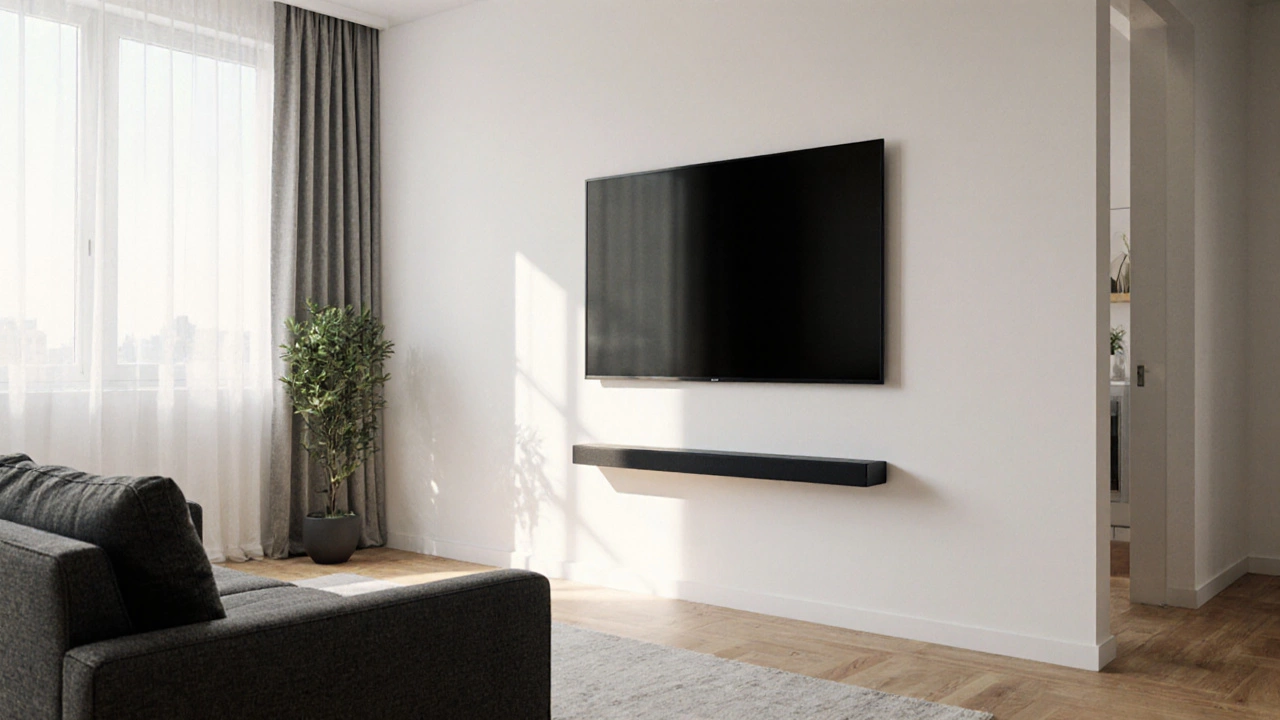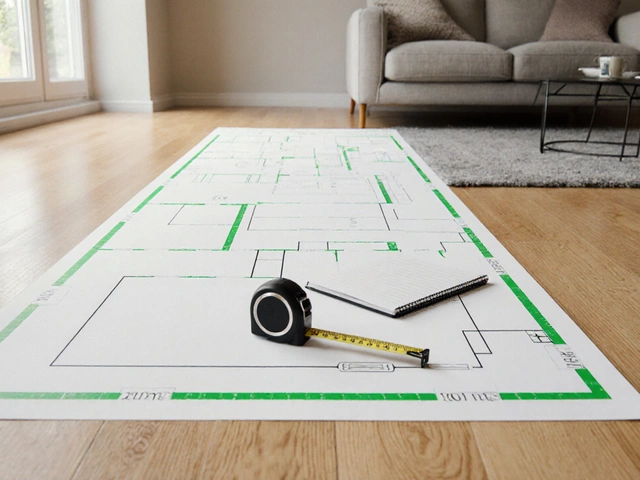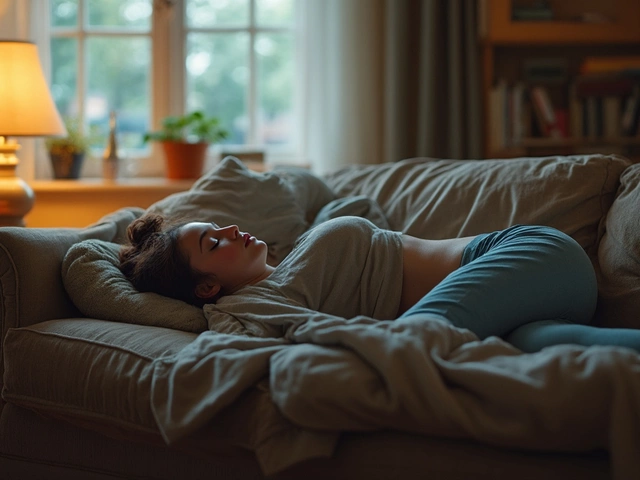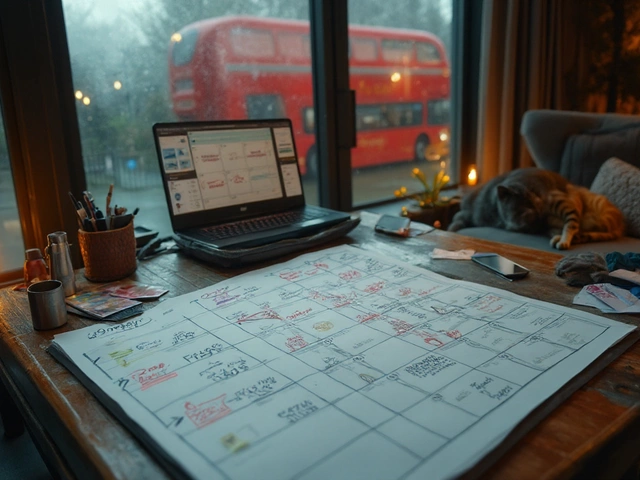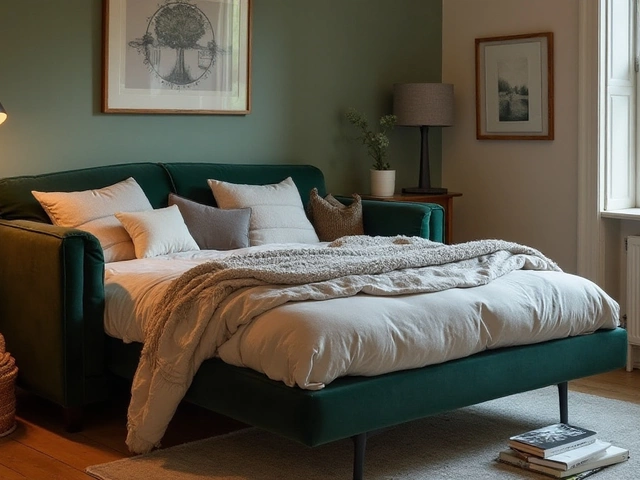TV Mounting Decision Calculator
Answer a few questions about your living room situation and we'll recommend whether a wall-mounted TV or TV stand is best for you.
Do you have children or pets?
Is your living room small (under 15m²)?
Do you need extra storage space?
How comfortable are you with DIY installation?
Do you rent your home?
Do you want a minimalist, clean look?
Your Recommendation
This recommendation is based on your answers. Review the comparison below to understand why this option is best for your situation:
Wall-mounted TV: Best for small spaces, minimalists, and DIY enthusiasts who want to save floor space and create a clean look. Requires professional installation for safety and proper positioning.
TV Stand: Best for families with children/pets, those needing extra storage, renters, or those who prefer a more flexible solution with built-in storage and easier relocation.
Trying to decide whether to slap your new flat‑screen TV on the wall or plop it on a stand can feel like a design dilemma that will affect the whole room. Both options have fans, both have drawbacks, and the right answer depends on how you use the space, how you move furniture, and even how you picture your next movie night. Below we’ll walk through the key factors, compare the pros and cons, and give you a simple checklist so you can make the call with confidence.
Wall‑mounted TV is a method of attaching a flat‑screen display directly to a wall using a mounting bracket. It frees floor space, creates a sleek, gallery‑like look, and often improves viewing angles when done right. In contrast, a TV stand is a piece of furniture that supports the TV at a comfortable height while also offering storage for devices, décor, and sometimes hidden wiring. Both solutions can look great, but they solve different problems.
Space‑Saving Benefits
When you’re dealing with a small living room or a cramped studio, every square foot counts. A wall‑mounted TV eliminates the footprint of a stand, letting you push a sofa closer to the viewing area or add a side table for drinks.
On the other hand, a TV stand can double as a storage unit. If you have a media console, a bookshelf, or a console table built into the stand, you’re essentially getting extra shelving without buying another piece of furniture. The trade‑off is that the footprint remains, but the storage may offset the space taken up.
Viewing Comfort and Ergonomics
Eye level matters. Research from the University of Sydney (2023) found that viewers who sit with the screen’s center at eye height report 30% less neck strain. A wall‑mounted TV can be positioned precisely at that height, but you’ll need an adjustable mounting arm if you want tilt or swivel.
A TV stand typically places the screen a few inches lower than a wall mount, which can be perfect for lower couches or floor‑seated viewing. Some stands have adjustable legs, letting you raise or lower the height without drilling into the wall.
Cable Management Made Easy
One of the biggest frustrations is a jungle of cords. With a wall‑mounted TV you can route HDMI, power, and speaker cables behind the wall or through a surface‑mounted raceway. This creates a clean, minimalist look, but it does require a bit of DIY or a professional installer.
TV stands often feature built‑in cable holes, grommets, or trays that hide wires beneath the unit. If you’re not comfortable opening up your wall, a stand gives you an immediate, low‑effort solution for tidy connections.
Installation Cost and Effort
Installing a wall‑mounted TV isn’t just about buying the bracket. You need to locate studs, possibly reinforce them, and ensure the wall can support the TV’s weight. A typical professional installation in Auckland runs between NZ$150‑$250, plus the cost of a good quality mounting bracket (NZ$80‑$200).
Setting up a TV stand is usually as simple as unpacking, assembling (if required), and placing the TV on top. Some stands arrive pre‑assembled, meaning you can have a functional setup in under 15 minutes and for under NZ$50.
Safety and Longevity
Safety concerns differ. A wall mount must be securely fastened; a poorly installed bracket can cause the TV to tumble, especially in homes with children or pets. Choosing a certified mounting bracket-look for the “UL‑listed” or “ETL‑certified” mark-helps mitigate that risk.
TV stands are stable by design, but they can tip if the TV is top‑heavy on a narrow base. Opt for stands with a wide footprint or a lower centre of gravity, and always keep the stand anchored to the wall with the supplied hardware if the manufacturer recommends it.
Aesthetic Impact
Modern interiors often favour clean lines and minimal clutter. A wall‑mounted TV contributes to that aesthetic, especially when paired with a recessed media wall or floating shelving. It can also make a room feel larger because there’s no bulky furniture breaking the sightline.
A TV stand can become a focal point itself. A mid‑century teak console, a sleek black lacquered unit, or a rustic reclaimed‑wood stand can add character and warmth. If you love the idea of mixing textures, a stand offers more visual interest than a plain wall.
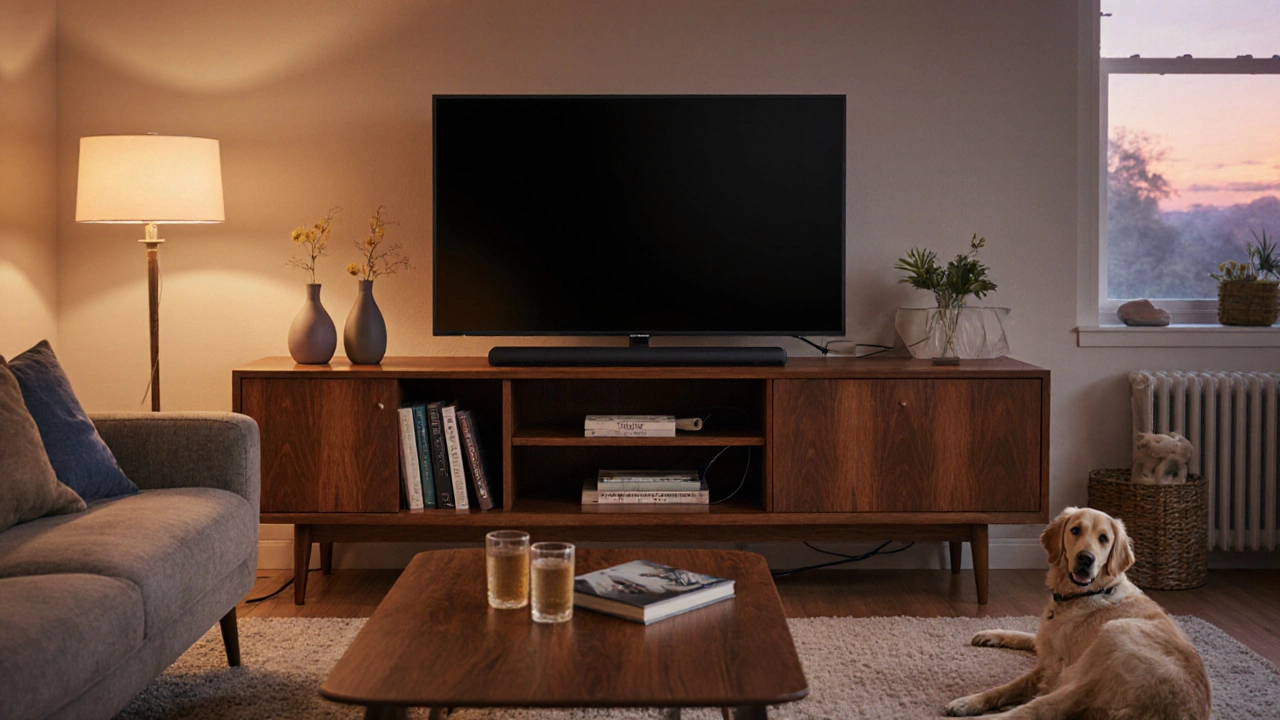
Resale Value and Flexibility
When you move, a wall‑mounted TV is easy to take down and reinstall in a new home-provided the new place has suitable wall studs. However, the mounting hardware stays with the TV, and you’ll need to assess the new wall’s condition.
A TV stand is portable. You can roll it on a dolly, carry it through narrow doorways, and it works in any room-great if you tend to re‑arrange or rent. Plus, a stylish stand can be a selling point for your home’s staging, adding perceived value to the living area.
Choosing the Right Option for Your Lifestyle
Here’s a quick decision guide:
- Small apartment, minimalist vibe: Wall‑mounted TV.
- Family with kids or pets: TV stand with anchoring.
- Need extra storage: TV stand with shelves.
- DIY‑savvy, want a clean look: Wall‑mounted TV with in‑wall cable management.
- Renters or frequent movers: TV stand.
Cheat‑Sheet Checklist
| Factor | Wall‑Mounted TV | TV Stand |
|---|---|---|
| Space usage | Zero floor footprint | Adds furniture footprint but offers storage |
| Installation cost | NZ$150‑$250 (professional) + bracket | Usually under NZ$50 (DIY) |
| Cable management | In‑wall or surface raceways for a clean look | Built‑in grommets/trays |
| Safety | Requires sturdy studs, certified brackets | Stable base; may need wall‑anchor for tall units |
| Aesthetic | Minimalist, modern | Can add style, texture, and character |
| Flexibility | Easy to relocate with proper hardware | Highly portable, works in any room |
Common Pitfalls and How to Avoid Them
- Ignoring stud location: Use a stud finder and double‑check before drilling. If the studs are oddly spaced, consider a wall‑plate system that spreads the load.
- Choosing the wrong bracket size: Check the TV’s VESA pattern (e.g., 400 × 400 mm) and weight rating. A bracket undersized for a 65‑inch TV can fail.
- Letting cables dangle: Plan the cable path ahead of time. For wall‑mounted setups, a simple 2‑inch conduit can hide everything.
- Buying a flimsy stand: Look for solid construction-metal frames, thick MDF, or solid wood. A good rule: the stand should support at least 20% more weight than the TV’s rating.
- Over‑looking ventilation: TVs need airflow. Ensure the stand’s rear panel is open or has vents, and that the wall‑mount bracket isn’t too tight.
Next Steps: Getting Your Setup Right
If you’ve decided on a wall‑mounted TV, start by measuring the viewing distance (roughly 1.5 × the TV’s diagonal) and pick a spot that aligns with your couch. Order a certified mounting bracket, grab a stud finder, and schedule a professional if you’re uneasy about the drill.
If a TV stand feels like the better fit, measure the width of your TV, add a few inches for breathing room, and choose a stand with a weight capacity of at least 1.5 × the TV’s weight. Add a few décor items-plants, books, a soundbar-to make the setup feel intentional.
Either way, take a step back, look at the room from a few feet away, and make sure the TV feels like part of the space, not an afterthought.
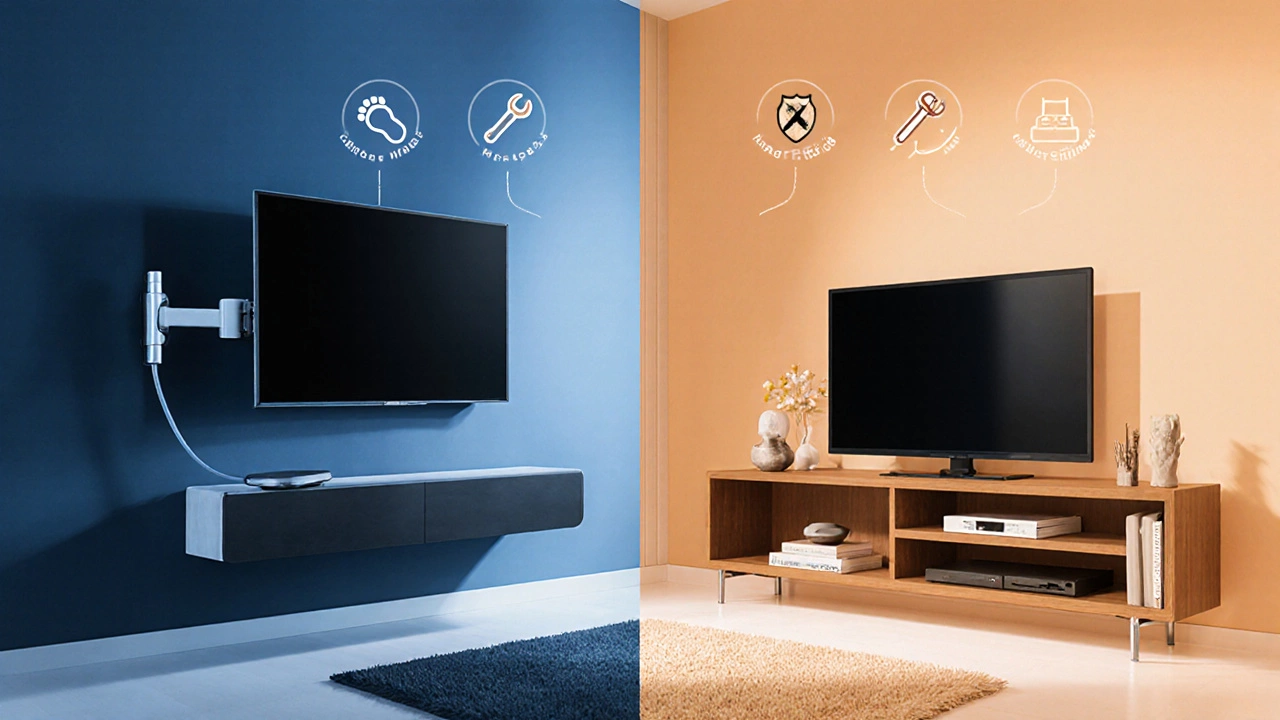
Is a wall‑mounted TV safe for families with kids?
Yes, if you use a UL‑listed bracket, locate it on solid studs, and follow the manufacturer’s weight limits. Adding a safety strap can give extra peace of mind.
Can I hide cables with a wall‑mounted TV?
Absolutely. In‑wall conduit or surface raceways let you run HDMI, power, and speaker cables behind the wall, creating a clean look.
Do TV stands affect picture quality?
Not directly. The only impact comes from the viewing height. Position the screen so the centre is at eye level for the best experience.
What is the average cost of a quality TV stand?
A sturdy mid‑range stand in New Zealand typically costs between NZ$150 and NZ$400, depending on material and finish.
How do I know if my wall can hold a large TV?
Check the wall type (brick, plasterboard, drywall). For plasterboard, locate wooden studs and use a bracket rated for the TV’s weight. If you’re unsure, a professional assessment is worth the safety.
